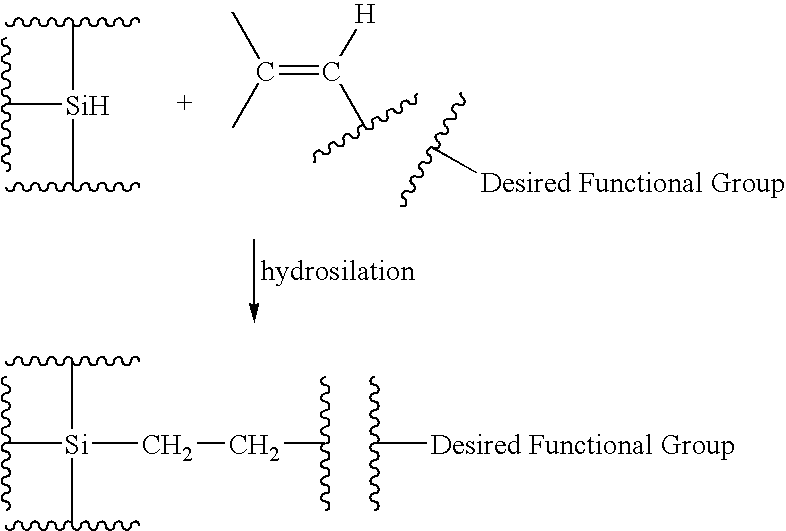Functionalized silicon compounds
a technology of functionalized silicon and carbosilane, applied in the field of functionalized silicon compounds, can solve the problems of ineffective methods for synthesizing functionalized carbosilanes and carbosiloxanes, and achieve the effects of reducing the reactivity of functional groups, eliminating the ability of functional groups to conjugate, and hindering reactions
- Summary
- Abstract
- Description
- Claims
- Application Information
AI Technical Summary
Benefits of technology
Problems solved by technology
Method used
Image
Examples
examples
[0116]The following examples illustrate the hydrosilation process and carbo-silicon products of the present invention and not to limit the scope thereof. One skilled in the art could readily modify any of the examples or specific embodiments described herein so as to optimize the process for optimal yield. Such modifications, as are made obvious by this disclosure, are intended to be part of this description though not expressly stated herein, and are intended to be within the spirit and scope of the invention.
examples 1-6
[0117]The Example process is carried out by placing an aliquot of the selected functionalized olefin reactant into a reaction flask equipped with an external heat source, a reflux condenser, a stirring apparatus, and a dropping funnel. The reaction flask thus charged is purged with nitrogen to maintain an inert atmosphere and the dropping funnel charged with the selected silicon reactant. The reaction is maintained under an inert atmosphere and 0.025 mole of chloroplatinic acid is added to the olefin reactant as a 0.1 M solution in isopropanol. The reaction flask is heated initially to about 110° C. After the initial temperature is reached, the silicon reactant is added dropwise with continued stirring. The reaction temperature is maintained at a temperature from about 100° C. to about 120° C. either by continued heating or by adjusting the rate of addition of the silicon reagent, or a combination of the two. After all of the silicon reactant has been added the reaction temperature ...
example 7
[0129]The following procedure was followed to convert a portion of the product prepared in Example 4 (1,1-dimethyl-5-(dimethylchloro-silyl)-pentanonitrile) to a disiloxane. Into a vessel was placed 19.1 g of potassium hydroxide dissolved in 175 ml of a solvent consisting of a water / ethanol mixture (80:20 v / v). To this solution, 17 g of the nitrile was added slowly (over about 30 minutes), resulting in a milky-white emulsion. The emulsion was brought to reflux and reflux was maintained for about 25 hours. When no ammonia evolution from the reflux condenser could be detected with pH paper, the reaction mixture was cooled to ambient temperature and acidified with aqueous HCl. The upper phase which formed upon acidification was isolated and extracted with 100 ml aliquots of chloroform. The extracts were combined and the chloroform was stripped in a rotary evaporator, leaving behind a viscous liquid. Infrared analysis confirmed that the product obtained was 1,3-bis[5-(2,2-dimethyl-pentan...
PUM
| Property | Measurement | Unit |
|---|---|---|
| hydrolyzable | aaaaa | aaaaa |
| reactivity | aaaaa | aaaaa |
| structure | aaaaa | aaaaa |
Abstract
Description
Claims
Application Information
 Login to View More
Login to View More - R&D
- Intellectual Property
- Life Sciences
- Materials
- Tech Scout
- Unparalleled Data Quality
- Higher Quality Content
- 60% Fewer Hallucinations
Browse by: Latest US Patents, China's latest patents, Technical Efficacy Thesaurus, Application Domain, Technology Topic, Popular Technical Reports.
© 2025 PatSnap. All rights reserved.Legal|Privacy policy|Modern Slavery Act Transparency Statement|Sitemap|About US| Contact US: help@patsnap.com



